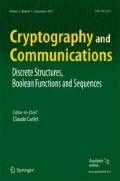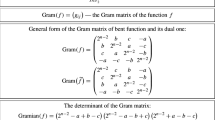Abstract
A bent function is a Boolean function in even number of variables which is on the maximal Hamming distance from the set of affine Boolean functions. It is called self-dual if it coincides with its dual. It is called anti-self-dual if it is equal to the negation of its dual. A mapping of the set of all Boolean functions in n variables to itself is said to be isometric if it preserves the Hamming distance. In this paper we study isometric mappings which preserve self-duality and anti-self-duality of a Boolean bent function. The complete characterization of these mappings is obtained for \(n\geqslant 4\). Based on this result, the set of isometric mappings which preserve the Rayleigh quotient of the Sylvester Hadamard matrix, is characterized. The Rayleigh quotient measures the Hamming distance between bent function and its dual, so as a corollary, all isometric mappings which preserve bentness and the Hamming distance between bent function and its dual are described.
Similar content being viewed by others
References
Carlet, C.: Boolean functions for cryptography and error correcting code. In: Crama, Y., Hammer, P.L. (eds.) Boolean models and methods in mathematics, computer science, and engineering, pp 257–397. Cambridge University Press, Cambridge (2010)
Carlet, C., Danielson, L.E., Parker, M.G., Solé, P.: Self-dual bent functions. Int. J. Inform. Coding Theory 1, 384–399 (2010)
Carlet, C., Mesnager, S.: Four decades of research on bent functions. Journal Des. Codes Cryptogr. Springer 78(1), 5–50 (2016)
Cusick, T.W., Stănică P.: Cryptographic Boolean functions and applications, p 288. Acad. Press, London (2017)
Danielsen, L.E., Parker, M.G., Solé, P: The Rayleigh quotient of bent functions, Springer Lect. Notes in Comp. Sci. 5921, pp 418–432. Springer, Berlin (2009)
Dillon, J.: Elementary Hadamard Difference Sets, PhD. dissertation. College Park, Univ Maryland (1974)
Feulner, T., Sok, L., Solé, P., Wassermann, A.: Towards the classification of self-dual bent functions in eight variables. Des. Codes Cryptogr. 68(1), 395–406 (2013)
Hou, X.-D.: Classification of self dual quadratic bent functions. Des Codes Cryptogr. 63(2), 183–198 (2012)
Hyun, J.Y., Lee, H., Lee, Y.: MacWilliams duality and Gleason-type theorem on self-dual bent functions. Des Codes Cryptogr. 63(3), 295–304 (2012)
Janusz, G.J.: Parametrization of self-dual codes by orthogonal matrices. Finite Fields Appl. 13(3), 450–491 (2007)
Kutsenko, A.V.: The Hamming distance spectrum between self-dual Maiorana–McFarland bent functions. J. Appl. Ind. Math. 12(1), 112–125 (2018)
Kutsenko, A.: Metrical properties of self-dual bent functions. Des. Codes Cryptogr. 88(1), 201–222 (2020)
Luo, G., Cao, X., Mesnager, S.: Several new classes of self-dual bent functions derived from involutions. Cryptogr. Commun. 11(6), 1261–1273 (2019)
MacWilliams, F.J., Sloane, N.J.A.: The theory of error correcting codes. North-Holland, Amsterdam (1977)
Markov A.A.: On transformations without error propagation. In: Selected works, Vol. II: Theory of algorithms and constructive mathematics. Mathematical Logic. Informatics and Related Topics, p. 70–93, MTsNMO, Moscow [Russian] (2003)
Mesnager, S.: Several new infinite families of bent functions and their duals. IEEE Trans. Inf. Theory 60(7), 4397–4407 (2014)
Mesnager, S.: Bent functions: Fundamentals and results, p 544. Springer, Berlin (2016)
Rothaus, O.S.: On bent functions. J. Combin. Theory. Ser. A 20(3), 300–305 (1976)
Sok, L., Shi, M., Solé, P.: Classification and Construction of quaternary self-dual bent functions. Cryptogr. Commun. 10(2), 277–289 (2018)
Tokareva, N.: The group of automorphisms of the set of bent functions. Discret. Math. Appl. 20(5), 655–664 (2010)
Tokareva, N.: Bent functions: Results and applications to cryptography, 230 p., Acad. Press Elsevier (2015)
Author information
Authors and Affiliations
Corresponding author
Additional information
Publisher’s note
Springer Nature remains neutral with regard to jurisdictional claims in published maps and institutional affiliations.
This article belongs to the Topical Collection: Boolean Functions and Their Applications IV
Guest Editors: Lilya Budaghyan and Tor Helleseth
The author was supported by the Russian Foundation for Basic Research (projects no. 18-07-01394, 20-31-70043), the study was supported within the framework of the state contract of the Sobolev Institute of Mathematics (project no. 0314-2019-0017) and Laboratory of Cryptography JetBrains Research.
Rights and permissions
About this article
Cite this article
Kutsenko, A. The group of automorphisms of the set of self-dual bent functions. Cryptogr. Commun. 12, 881–898 (2020). https://doi.org/10.1007/s12095-020-00438-y
Received:
Accepted:
Published:
Issue Date:
DOI: https://doi.org/10.1007/s12095-020-00438-y



